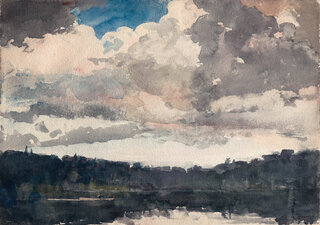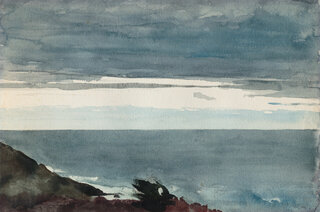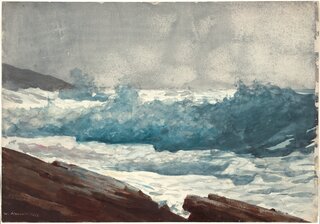
In January 1904, Homer traveled to Homosassa, Florida, to fish. The Homosassa River, on the gulf side of the state, was home to many fish species and supported a lush wildlife habitat. It was in Homosassa that Homer painted his final tropical watercolors, including Life-Size Black Bass. In this work, the artist placed the underside of the huge, brightly colored fish at center and close to the viewer, bringing alive the drama, immediacy, and excitement of the fisherman’s experience as his fly, a “scarlet ibis,” hangs in the air. With trademark ambiguity, Homer presented the bass suspended between life and death. Will it succeed in grabbing its bright target only to seal its fate? The fish’s sudden jump slices through the dark, quiet jungle with a momentary flash of life and color.
In order to force the viewer into the path of the leaping fish, Homer cropped three centimeters off the lower edge of Life-Size Black Bass. He then centered and framed the fish for maximum effect by trimming a total of 2 centimeters from the right and left edges. The sheet dimensions are 350 x 526 millimeters; the original sheet dimensions were 380 x 545 millimeters as compared with uncut sheets of the same paper type. The trimmed edges appear slightly uneven and lack any adhesive residue from the watercolor paper block. As in a photograph with a short focal length, Homer presented the fish in tight focus against a vague and fluid background. With these compositional choices Homers heightened the tension of the strong, vital bass, frozen in motion, before capture and death. Such dramatic psychological impact results from Homer’s three decades of persistent observation using watercolor to transcribe nature on paper.









